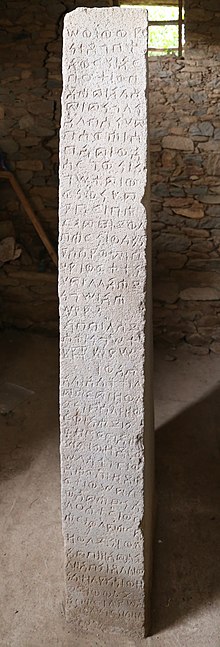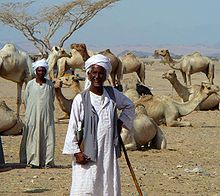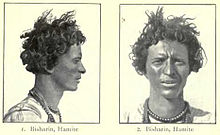Beja people
Oobja | |
|---|---|
 | |
| Total population | |
| 3,597,000 | |
| Regions with significant populations | |
| 2,371,000 | |
| 1,099,000 | |
| 127,000 | |
| Languages | |
| Beja · Sudanese Arabic · Tigre | |
| Religion | |
| Related ethnic groups | |
| Ababda · Afar · Agaw · Oromo · Saho · Somali · Tigre · other Cushitic-language speaking peoples | |
The Beja people (Beja: Oobja, Arabic: البجا, Tigre: በጃ) are an ethnic Cushitic-language speaking people inhabiting Sudan, Egypt, and Eritrea. In recent history, they have lived primarily in the Eastern Desert. They number around 1,237,000 people.[1] The majority of Beja people speak the Beja language as a mother tongue, which belongs to the Cushitic branch of the Afro-Asiatic family. In Eritrea and southeastern Sudan, many members of the Beni Amer grouping speak Tigre. While many secondary sources identify the Ababda as an Arabic-speaking Beja tribe due to their cultural links with the Bishaari, this is a misconception: The Ababda do not consider themselves Beja, nor are they so considered by other Beja peoples.[2]
History[]

The Beja are traditionally Cushitic-speaking pastoral nomads native to northeast Africa, formerly referred to as Blemmyes. A geographer named Abu Nasr Mutahhar al-Maqdisi wrote in the tenth century that the Beja were at that time Christians.[3] Beja territories in the Eastern desert were made tributary by the Kingdom of Aksum in the third century.[4] The Beja were Islamized beginning in the 15th century. The now-Islamic Beja participated in the further Muslim conquest of Sudan, expanding southward. The Hadendoa Beja by the 18th century dominated much of eastern Sudan. In the Mahdist War of the 1880s to 1890s, the Beja fought on both sides, the Hadendoa siding with the Mahdist troups, while the Bisharin and Amarar tribes sided with the British,[5] and some Beni Amer - a subset of the Beja who live largely in modern Eritrea - sided with the Ethiopian Ras Alula in certain battles, such as .[6]

The Beja Congress was formed in 1952 with the aim of pursuing regional autonomy from the government in Khartoum. Frustrated by the lack of progress, the Beja Congress joined the insurgent National Democratic Alliance in the 1990s. The Beja Congress effectively controlled a part of eastern Sudan centered on Garoura and Hamshkoraib. The Beja Congress sabotaged the oil pipeline to Port Sudan several times during 1999 and 2000. In 2003, they rejected the peace deal arranged between the Sudanese government and the Sudan People's Liberation Army, and allied with the rebel movement of the Darfur region, the Sudan Liberation Movement/Army, in January 2004. A peace agreement was signed with the government of Sudan in October 2006. In the general elections in April 2010, the Beja Congress did not win a single seat in the National Assembly in Khartoum. In anger over alleged election fraud and the slow implementation of the peace agreement, the Beja Congress in October 2011 withdrew from the agreement, and later announced an alliance with the Sudan Liberation Movement/Army.
Geography[]

The Beja people inhabit a general area between the Nile River and the Red Sea in Sudan, Eritrea and eastern Egypt known as the Eastern Desert. Most of them live in the Sudanese states of Red Sea around Port Sudan, River Nile, Al Qadarif and Kassala, as well as in Northern Red Sea, Gash-Barka, and Anseba Regions in Eritrea, and southeastern Egypt. There are smaller populations of other Beja ethnic groups further north into Egypt's Eastern Desert. Some Beja groups are nomadic. The Kharga Oasis in Egypt's Western Desert is home to a large number of Qamhat Bisharin who were displaced by the Aswan High Dam. Jebel Uweinat is revered by the Qamhat.
Names[]
The Beja have been named "Blemmyes" in Roman times,[7] Bəga in Aksumite inscriptions in Ge'ez,[8] and "Fuzzy-Wuzzy" by Rudyard Kipling. Kipling was specifically referring to the Hadendoa, who fought the British, supporting the Mahdi, the Sudanese leader of the war against Turkish-Egyptian rule, supported by the British Imperial administration.[5]
Language[]

The Beja speak the Beja language, known as Bidhaawyeet or Tubdhaawi in that language. It belongs to the Cushitic branch of the Afroasiatic family.[1]
The French linguist Didier Morin (2001) has made an attempt to bridge the gap between Beja and another branch of Cushitic, namely Lowland East Cushitic languages and in particular Afar and Saho, the linguistic hypothesis being historically grounded on the fact that the three languages were once geographically contiguous.[9] Most Beja speak the Beja language, but certain subgroups use other lingua franca. The Beni Amers speak a variety of Tigre, whereas most of the Halengas speak Arabic.[9]
Although there is a marked Arabic influence, the Beja language is still widely spoken. The very fact that the highest moral and cultural values of this society are in one way or the other linked to their expression in Beja, that Beja poetry is still highly praised, and that the claims over the Beja land are only valid when expressed in Beja, are very strong social factors in favour of its preservation. True enough Arabic is considered as the language of modernity, but it is also very low in the scale of Beja cultural values as it is a means of transgressing social prohibitions. Beja is still the prestigious language for most of its speakers because it conforms to the ethical values of the community.[9]
Subdivisions[]

The Bejas are divided into clans. These lineages include the Bisharin, Hedareb, Hadendowa (or Hadendoa), the Amarar (or Amar'ar), Beni-Amer, , , Belin and Hamran, some of whom are partly mixed with Bedouins in the east.
Beja society was traditionally organized into independent kingdoms. According to Al-Yaqubi, there were six such Beja polities that existed between Aswan and Massawa during the 9th century. Among these were the Kingdom of Bazin, Kingdom of Belgin, Kingdom of Jarin, Kingdom of Nagash, Kingdom of Qita'a and Kingdom of Tankish.[10]
See also[]
References[]
- ^ Jump up to: a b "Bedawiyet". Ethnologue. Retrieved 14 October 2016.
- ^ ضرار, محمّد صالح (2012). تاريخ شرق السودان. Khartoum: مكتبة التوبة. p. 36.
- ^ Ruffini, Giovanni. "Abu Nasr Mutahhar al-Maqdisi". Medieval Nubia: A Source Book. Retrieved 19 June 2018.
- ^ Hatke, George. "Aksum and Nubia: Warfare, Commerce, and Political Fictions in Ancient Northeast Africa". Institute for the Study of the Ancient World. New York University. Retrieved 19 June 2019.
- ^ Jump up to: a b Orville Boyd Jenkins, Profile of the Beja people (1996, 2009).
- ^ Wingate, Francis (1891). Mahdiism and the Egyptian Sudan: Being an Account of the Rise and Progress of Mahdiism and of Subsequent Events in the Sudan to the Present Time. London: Macmillan and Company. p. 230.
- ^ Stanley Mayer Burstein, Ancient African Civilizations: Kush and Axum, p. 167 (2008)
- ^ Hatke, George. "Aksum and Nubia: Warfare, Commerce, and Political Fictions in Ancient Northeast Africa". Ancient World Digital Library. NYU Press. Retrieved 29 May 2020.
- ^ Jump up to: a b c Martine Vanhove, The Beja Language Today in Sudan: The State of the Art in Linguistics 2006.
- ^ Elzein, Intisar Soghayroun (2004). Islamic Archaeology in the Sudan. Archaeopress. p. 13. ISBN 1841716391. Retrieved 13 March 2015.
Further reading[]
Ethnography[]
- Morton, John (1988). "Sakanab: Greetings and Information among the Northern Beja". Africa. 58 (4): 423–436. doi:10.2307/1160350. JSTOR 1160350.
- Morton, John (1989). Descent, Reciprocity and Inequality among the Northern Beja (Thesis). University of Hull.
- Hjort af Ornäs, Anders; Dahl, Gudrun (1991). Responsible Man: the Atmaan Beja of North-eastern Sudan. Uppsala: Stockholm Studies in Social Anthropology. ISBN 9171469052.
- Jacobsen, Frode (1998). Theories of Sickness and Misfortune among the Hadandowa Beja of the Sudan: Narratives as Points of Entry into Beja Cultural Knowledge. London: Kegan Paul International. ISBN 0710305915.
- Fadlalla, Amal (2007). Embodying Honor: Fertility, Foreignness, and Regeneration in Eastern Sudan. Madison: The University of Wisconsin Press. ISBN 978-0299223809.
History[]
- A. Paul. A history of the Beja tribes of the Sudan, Cambridge University Press, 2012.
External links[]
| Wikimedia Commons has media related to Beja people. |
- Beja people
- Ethnic groups in Egypt
- Ethnic groups in Eritrea
- Ethnic groups in Sudan
- Ethnic groups in the Arab world
- Cushitic-speaking peoples
- Pastoralists
- African nomads
- Modern nomads
- Indigenous peoples of North Africa
- Indigenous peoples of East Africa
- Blemmyes
- Ethnic groups in the Middle East